
|

|

|
The Eye of the Storm February 16, 1998 By Mark Hoover previous | next All is quiet, except for the sound of the surf upon the rocks of Isla Isabella. It is midnight in the eye of El Niño, and the Southern Cross hangs low in the sky, counterpoint to the rising moon. Hanging my feet in the water as I write, I drink in the serenity of the darkened boat and the delicate breeze coming off the water. All are asleep...except me. Yesterday I walked with Mike McPhaden along a beach walked a century ago by another man looking for the pieces to a puzzle, who came to the Galapagos during an El Niño year. His name was Charles Darwin. As we flew on Saturday from the cool mountains of Quito down into the thick hot air of Guayaquil on the coast, I saw with each passing mile a land increasingly inundated by the floodwaters of what locals call simply the "fenómenos," or "phenomenon." As we drew closer to the city, the land simply disappeared in many places, covered by vast sheets of tea-brown water bearing a scum of foam, sticks, pieces of houses, and other jetsam torn loose by El Niño's rains. I could only imagine the misery of the inhabitants.  We changed planes in Guayaquil. Ominous clouds filled the sky,
seething as they headed inland, and a fine sticky rain hung in
the air. Our flight to the Galapagos would take an hour and a
half, all of it flying through more clouds like these.
We changed planes in Guayaquil. Ominous clouds filled the sky,
seething as they headed inland, and a fine sticky rain hung in
the air. Our flight to the Galapagos would take an hour and a
half, all of it flying through more clouds like these.Confounding my expectations, it was not raining when we touched down on the crushed-lava tarmac of Galapagos' lone runway. Hot, yes, and humid, but curiously still...and everywhere, green shoots and vines the color of August apples crowded the cacti and scrub. A rattletrap bus took us a couple of miles to the harbor where we joined the crew of the Orca, our boat. We also met the naturalist and field guide who would help us find the evidence of the changes El Niño brings to the archipelago. After loading the considerable gear of the film crew, and pulling up the anchor, we headed for the first stop: Isla Bartolomé, in search of the Galapagos penguin.
Peter and Rosemary Grant of Princeton have conducted a unique study of finches on Daphne Major for more than two decades; their work was the basis of Jonathan Wiener's critically acclaimed book, The Beak of the Finch. This tiny island has revealed, through the work of the Grants, that evolution can work on time scales once considered ridiculously short. Indeed, the Grants have evidence that the finches of Daphne Major somehow anticipate the changed environment of El Niño years, and quickly produce numbers of variant individuals with beaks and bodies more suited to the lusher foods and conditions El Niño brings. These birds carry in their genes a program for adaptation to El
We moved on across the ocean toward Bartolomé, and the clouds parted. I marveled at the weather. The heat and humidity were stifling, but there was no rain, and only a light chop in the sea. Only later would it start to make sense.  Ahead, sunlight illuminated an obelisk jutting from the water;
its exotic, blackened spire beckoned, and we marked a course
to take us near. Slipping past it, we saw Galapagos penguins
standing and diving at its base. They waddled to the edge of
the lava, dove like Olympians into the warm sea, and shimmied
their tails as they climbed out of the water to repeat their
happy enterprise again. Yes, they were penguins all right: but
penguins standing on baked lava under an equatorial sun. They
caught Darwin's fancy, too.
Ahead, sunlight illuminated an obelisk jutting from the water;
its exotic, blackened spire beckoned, and we marked a course
to take us near. Slipping past it, we saw Galapagos penguins
standing and diving at its base. They waddled to the edge of
the lava, dove like Olympians into the warm sea, and shimmied
their tails as they climbed out of the water to repeat their
happy enterprise again. Yes, they were penguins all right: but
penguins standing on baked lava under an equatorial sun. They
caught Darwin's fancy, too.Galapagos marks the northernmost latitude in which one can find penguins, and the population here is obviously a relict, or a group left behind when changing climate altered the former range of the species, and left no avenue of retreat (the Florida jaguar is a similar example). During the 1982 El Niño, a lot—perhaps two thirds—of these penguins died, creating concerns over their very survival. It has taken almost two decades for them to recover. Our naturalist tells us that so far this year, the casualties have been mild. No one knows quite why; El Niño seems to choose its victims with a roll of the dice. Rounding the spire, we found a small bay, and set out in a motor launch for it. Mike McPhaden jumps out of the boat, ahead even of the film crew as we approach the beach. I know what motivates him; I feel it myself. Sirenlike, the
The abandoned nests of sea turtles ring the beach, cones of sand with the middles scooped out. Fingers of black lava the thickness of my thigh lie frozen on the sand, evidence of an eruption not many centuries ago, judging from the lack of erosion in the bubbled rock. The beach is littered with the rock fragments created when these sizzling columns exploded upon touching the sea. We hike inland. As we traverse the stony soil, armies of tiny lava lizards spring from hiding places, like frogs jumping into a pond. Mike stoops at a fount of clear water emerging from what seems solid rock—the porous rocks have been filled with rainwater, more of El Niño's handiwork. The crew sets up to film near the bay; Mike and I cross a sand ridge and in a few minutes come to a cove on the other side of the island. Blue-footed boobies lope and wheel through the air a hundred feet up. Without warning, one, then another folds its wings, rolls, and dives straight down into the sea, disappearing. Moments later, they arise in a spume of bubbles, sometimes with a fish in their beak. Boobies, too, suffered mightily in 1982. This year, El Niño's effect is more subtle. Mortality has been spotty, but the birds roam endlessly, with a catch being the exception, not the rule. So far, however, they have avoided disaster.
The still form is so perfect it seems an atrocity that the life has gone out of it. With morbid curiosity, I look closely at its face...and fall backwards into the water as the sea lion suddenly awakens from a reverie and barks joy at his newfound playmates. He had been napping, apparently, or just enjoying the feel of the surf. We wad out into the warm water, and the sea lion cavorts and barks and swims between my legs with effortless speed. Without predators, the Galapagos sea lion has never learned to fear. I say a silent prayer that no humans will ever introduce the idea.
The sun is setting as we approach our boat and the dinner of Peruvian potatoes and ceviche that awaits. Mike and I say little. Mike has spent his life studying El Niño from an oceanographer's point of view, but this is the first time he has actually been inside El Niño himself, rather than with a scientific instrument. His data is no longer numbers; it is his own five senses. I ask him what he is thinking. He pauses a long moment, as he reorients himself to the realm of words. 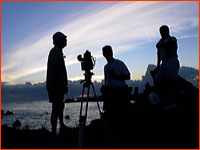 "We are in the eye of the storm here, aren't we? What a
paradox...where El Niño is most intense, it is least
visible....." He pauses. "There's a lesson in what we saw
today, a symmetry that reminds me of El Niño's
essential nature. That's the key word: nature. Life has
adapted here to El Niño, and that's the most compelling
proof I can think of that it is part of the natural
give-and-take, one of the living rhythms of the Earth, its
oceans, and its atmosphere." He pauses again. "During El
Niño, it's not the Earth that's out of balance. It's
us."
"We are in the eye of the storm here, aren't we? What a
paradox...where El Niño is most intense, it is least
visible....." He pauses. "There's a lesson in what we saw
today, a symmetry that reminds me of El Niño's
essential nature. That's the key word: nature. Life has
adapted here to El Niño, and that's the most compelling
proof I can think of that it is part of the natural
give-and-take, one of the living rhythms of the Earth, its
oceans, and its atmosphere." He pauses again. "During El
Niño, it's not the Earth that's out of balance. It's
us."
previous dispatch | next dispatch | table of contents Photos: (2,3,5) Marcia Storkerson. Anatomy of El Niño | Chasing El Niño | El Niño's Reach Dispatches | Resources | Mail | Site Map | El Niño Home Editor's Picks | Previous Sites | Join Us/E-mail | TV/Web Schedule About NOVA | Teachers | Site Map | Shop | Jobs | Search | To print PBS Online | NOVA Online | WGBH © | Updated November 2000 |
||||||||||||||
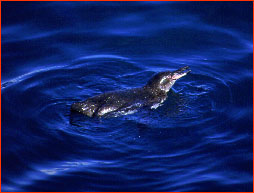 Galapagos Penguin
Galapagos Penguin

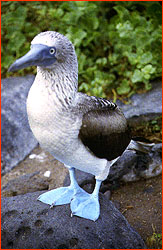 Blue-Footed Booby
Blue-Footed Booby
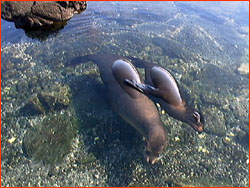 Sea Lions
Sea Lions
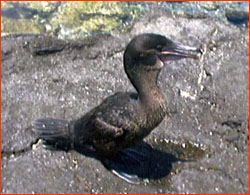 Flightless Cormorant
Flightless Cormorant